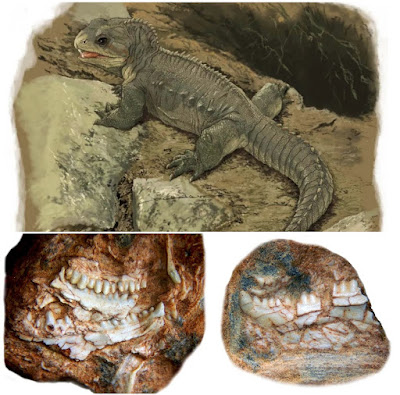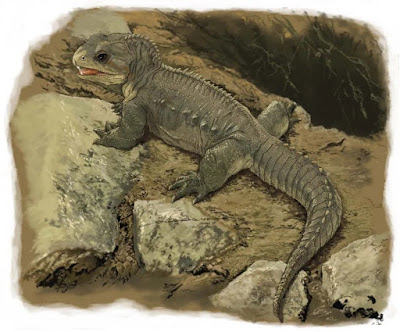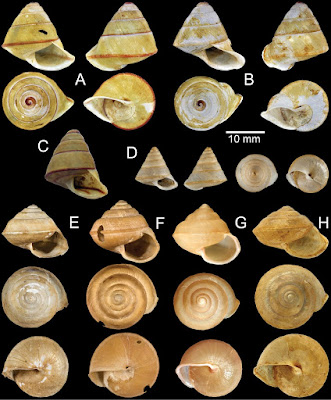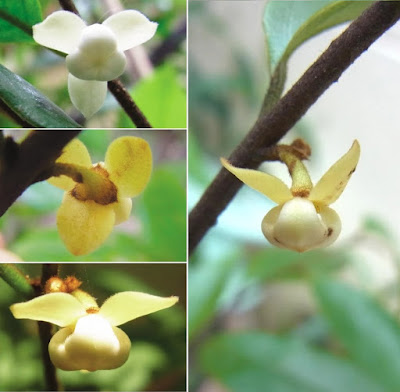[Most Recent Entries] [Calendar View]
Monday, August 19th, 2019
| Time | Event | ||||
| 1:24a | [Paleontology • 2019] Clevosaurus hadroprodon • A New Clevosaurid from the Triassic (Carnian) of Brazil and the Rise of Sphenodontians in Gondwana
Abstract The early evolution of lepidosaurs is marked by an extremely scarce fossil record during the Triassic. Importantly, most Triassic lepidosaur specimens are represented by disarticulated individuals from high energy accretion deposits in Laurasia, thus greatly hampering our understanding of the initial stages of lepidosaur evolution. Here, we describe the fragmentary remains of an associated skull and mandible of Clevosaurus hadroprodon sp. nov., a new taxon of sphenodontian lepidosaur from the Late Triassic (Carnian; 237–228 Mya) of Brazil. Referral to Sphenodontia is supported by the combined presence of a marginal dentition ankylosed to the apex of the dentary, maxilla, and premaxilla; the presence of ‘secondary bone’ at the bases of the marginal dentition; and a ventrally directed mental process at the symphysis of the dentary. Our phylogenetic analyses recover Clevosaurus hadroprodon as a clevosaurid, either in a polytomy with the Late Triassic to Early Jurassic Clevosaurus and Brachyrhinodon (under Bayesian inference), or nested among different species of Clevosaurus (under maximum parsimony). Clevosaurus hadroprodon represents the oldest known sphenodontian from Gondwana, and its clevosaurid relationships indicates that these sphenodontians achieved a widespread biogeographic distribution much earlier than previously thought. Systematic Palaeontology Lepidosauria Dumeril and Bibron, 1839 sensu Evans, 1984 Rhynchocephalia Günther, 1867 sensu Gauthier et al., 1988 Sphenodontia Williston, 1925 sensu Benton, 1985 Clevosauridae Bonaparte and Sues, 2006 (sensu this study) Clevosaurus hadroprodon sp. nov. Etymology: Species epithet comes from a combination of ‘hadroprodon’ (from the Greek “hadros”-meaning large) and “protos”, meaning first (Greek), and “odous”, meaning tooth (Greek); in reference to the “big first tooth”, i.e. the large tusk-like tooth of the premaxilla and the anteriormost/first dentary tooth position. Locality and horizon: Linha Bernardino locality, Candelária municipality, Rio Grande do Sul State, Southern Brazil (Fig. 1); Santa Maria Formation (Santa Maria Supersequence, Candelária Sequence), Rosário do Sul Group, Paraná Basin; Carnian, Late Triassic. ..... Diagnosis: Small sphenodontian rhynchocephalian differing from all other known sphenodontians in possessing the following combination of features: (1) a large, blunt, tusk-like tooth in both premaxilla and first tooth position of dentary; (2) in having an angled, but nearly vertical mandibular symphysis and relatively deep dentary; (3) absence of an edentulous gap between the tusk-like tooth and the remaining dentition; (4) absence of a posterodorsal process of the premaxilla; (5) in lacking well-developed medial-posteromedial expansion of the posterior dentition; (6) and lacking flanges on the teeth, and (7) lacking labially expanded teeth. Feature 4 makes this new taxon different from many sphenodontians, including other species of Clevosaurus, Rebbanasaurus, Godavariasaurus, Priosphenodon, Sphenotitan, Paminzisaurus and Ankylosphenodon. Features 5 and 6 make this taxon different from all other described species of Clevosaurus [Clevosaurus hudsoni, C. bairdi, C. latidens, C. sectumsemper, C. cambrica, and Clevosaurus sp. (China)]
Annie S. Hsiou, Randall L. Nydam, Tiago R. Simões, Flávio A. Pretto, Silvio Onary, Agustín G. Martinelli, Alexandre Liparini, Paulo R. Romo de Vivar Martínez, Marina B. Soares, Cesar L. Schultz and Michael W. Caldwell. 2019. A New Clevosaurid from the Triassic (Carnian) of Brazil and the Rise of Sphenodontians in Gondwana. Scientific Reports. 9, 11821. nature.com/articles/s41598-019-48297-9 In the shadow of the dinosaurs eurekalert.org/e/9Q6y via @EurekAlert | ||||
| 10:27a | [Mollusca • 2019] Ganesella halabalah • Redescription of the Type Species of the Genera Ganesella Blanford, 1863 and Globotrochus Haas, 1935 (Eupulmonata, Camaenidae); with Description of A New Ganesella Species from Thailand Abstract The taxonomy of the speciose genus Ganesella W.T. Blanford, 1863 and the endemic genus Globotrochus Haas, 1935 is unclear since the anatomical characters of the the type species of these two genera have never been reported before. Therefore, the present paper provides the first anatomical descriptions of the reproductive apparatus, pallial system and radula of Helix capitium Benson, 1848 and Helix onestera Mabille, 1887, the respective type species of Ganesella and Globotrochus. In addition, Ganesella rhombostoma (Pfeiffer, 1861) and Ganesella carinella (Möllendorff, 1902) from Thailand are re-described, and a new species, Ganesella halabalah Sutcharit & Panha, sp. nov., from southern Thailand is described. This new species differs from all others by having a larger shell, an obtuse apex and an aperture lip with a prominent beak-like deflection. Keywords: anatomy, Cerastidae, Indochina, Orthurethran, Southeast Asia, synonym, systematics, tree snail Ganesella halabalah Sutcharit & Panha, sp. nov. Diagnosis: The dextral, large, trocoid shell with pale green to yellow colour, obtuse apex and apertural lip with prominent beak-like deflection. Etymology: The specific name is derived from the type locality Hala-Bala Wildlife Sanctuary, Narathivat, Thailand. Distribution: This new species is currently known from the type locality (in Narathivat, Thailand) and Gunung Tahan, Kelantan, Malaysia, which is about 150 km south of the type locality. The latter shell (Fig. 4C) was collected in 1901 in a tropical rain forest. This shell is in all aspects identical to the unique name-bearing type. Remarks: Even though Ganesella halabalah sp. nov. is described from empty shells, its unique features mean that it cannot be confused with any other camaenid species from the area. Yet, with its trochoid shell and its prominent, beak-like apertural rostrum, G. halabalah sp. nov. does resemble a Papuininae phenotype. However, the geographic distribution of the Papuininae is largely restricted to New Guinea, Australia and Melanesia (Schileyko 2003), though excluding the Greater Sunda Islands and Indochina. Given that the Malay Peninsula is a remote area for land snail dispersal between Australasia and Indochina (Hausdorf 2000), further anatomical and molecular evidence is needed to assess an eventual relationship with Papuininae. .... Chirasak Sutcharit, Thierry Backeljau and Somsak Panha. 2019. Re-description of the Type Species of the Genera Ganesella Blanford, 1863 and Globotrochus Haas, 1935; with Description of A New Ganesella species from Thailand (Eupulmonata, Camaenidae). ZooKeys. 870: 51-76. DOI: 10.3897/zookeys.870.36970 | ||||
| 10:55a | [Botany • 2019] Mitrephora chulabhorniana (Annonaceae) พรหมจุฬาภรณ์ • An Extraordinary New Species from A Karst Habitat of southern Thailand
Abstract Mitrephora chulabhorniana, a remarkable new species with the smallest flowers in the genus, is described and illustrated. The new species, from a karst habitat of southern Thailand, morphologically most resembles M. andamanica, which is endemic to the Middle and North Andaman Islands, but differs primarily by having narrower leaves, shorter inner petals, and lower number of stamens and carpels per flower. The conservation status of M. chulabhorniana is assessed and a key to the species of Mitrephora in Thailand is given. Keywords: Limestone, morphology, new species, Southeast Asia, taxonomy Mitrephora chulabhorniana Damth., Aongyong & Chaowasku, sp. nov. Etymology.— The epithet is to honor HRH Princess Chulabhorn, the youngest daughter of the late King Rama IX of Thailand. Princess Chulabhorn has a strong interest in science and has initiated the establishment of the “Chulabhorn Research Institute” principally to promote and conduct basic as well as applied scientific research of national importance for the improvement of mankind’s quality of life. One of her areas of expertise is the field of “natural products”, and the new species herein described might contain bioactive compounds (as evidenced by previous studies on other species of Mitrephora, e.g. Zgoda-Pols et al., 2002; Li et al., 2009; Mueller et al., 2009; Moharam et al., 2010; Rayanil et al., 2013), possibly leading to the discovery of new drugs. Anissara Damthongdee, Kithisak Aongyong and Tanawat Chaowasku. 2019. Mitrephora chulabhorniana (Annonaceae), An Extraordinary New Species from southern Thailand. Brittonia. DOI: 10.1007/s12228-019-09573-0 คณะวิทย์ มช. ค้นพบพืชชนิดใหม่ของโลก ได้รับพระราชทานนาม “พรหมจุฬาภรณ์” worldvarietynews.com/cmu-chulabhorniana/ การค้นพบพืชชนิดนี้ สืบเนื่องจากคณะนักวิจัย นำโดย อาจารย์ ดร.ธนวัฒน์ เชาวสกู สังกัดภาควิชาชีววิทยา คณะวิทยาศาสตร์ ร่วมด้วยนางสาวอานิสรา ดำทองดี นักศึกษาระดับบัณฑิตศึกษา สาขาวิชาความหลากหลายทางชีวภาพและชีววิทยา การวิจัยครั้งนี้ได้ค้นพบพืชชนิดใหม่ของโล ด้วยสำนึกในพระกรุณาธิคุณ สมเด็จเจ้าฟ้าฯ กรมพระศรีสวางควัฒน วรขัตติยราชนารี ที่ทรงสนพระทัยการศึกษาวิจัยในสาขาวิทยาศา การค้นพบ "พรหมจุฬาภรณ์" ได้รับการตีพิมพ์ในวารสารวิชาการระดับนานา |
| << Previous Day |
2019/08/19 [Calendar] |
Next Day >> |
































